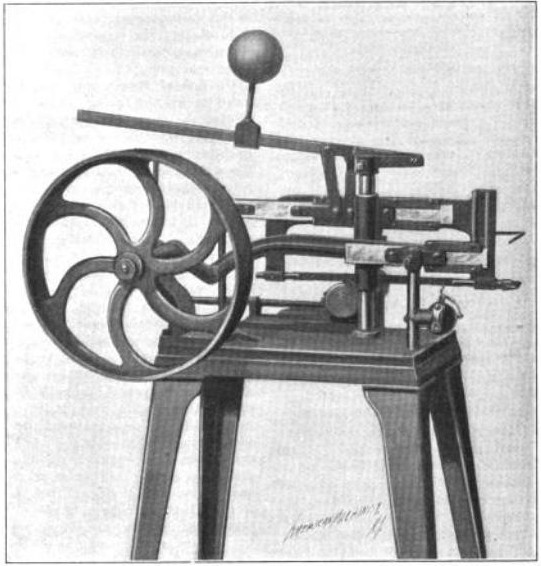Inventor and manufacturer Leverett Homer Olmsted made numerous items under the name L. H. Olmsted. Those of interest to the Vintage Machinery site include drill chucks, drill presses, bench drills, and power hacksaws. Some of his products outside our areas of interest include oil lamps, miter boxes, paper (bill) filing folders, hand embossers, and mole traps.
In 1861 Olmsted was in Stamford, Connecticut and was making patent oil cans. In 1863 he patented a ratchet brace that was manufactured by Davenport & Betts of Stamford. Around that time he moved to Yonkers, NY and then to Newark, NJ. He seems to have had some involvement with the Lysander Wright Machine Works of Newark. By 1866 he was back in Stamford and was making an improved oil can. as well as a new patent drill chuck, which was one of the very first to use three evenly-spaced jaws. His three-jawed chuck was successful and Olmsted manufactured it for several years. By 1868 Olmstead was living in Brooklyn and invented and began selling a paper-file, which was a system for organizing bills and related paperwork. He had an office at 1 Centre street in New York City. Beginning in 1877 he was granted a series of patents for oil-lamps, which he manufactured. Judging by the number of surviving examples these were also fairly good sellers.
Olmsted's patent oil cans, which had a round weighted bottom, were quite successful and were widely sold through various hardware retailers. At some point in the late 1860s they changed from being "Olmsted oilers" to "Olmstead oilers" (note the variant spelling of the surname), which seems to mark a transition to being manufactured by J. H. White of Newark.
By 1886 Olmsted had moved to Corona, NJ, where he patented and manufactured a miter box and then a mole-trap. He published a 12-page booklet on how to catch and kill moles, which was really an advertorial for his trap. By 1890 his business address was Hasbrouck Heights, NJ, where it would remain, though Olmsted himself continued to move around within New Jersey. In 1890 he introduced a bottle-capper drill press of quality construction and, soon after, a floor-standing drill press. Neither of these were patented and both are exceedingly uncommon. Then in 1901 he patented a power hacksaw and published a 16-page booklet on the history of saws and power hacksaws—which was, of course, an advertorial for his power hacksaw. The power hacksaw continued in production for a decade until Olmsted's death in 1911, after which time the ads for his products were from L. H. Olmsted's Son. The products themselves were manufactured by the firm of L. H. Olmsted and continued to bear that name.
 |
| Article illustration from 1902-12-11 American Machinist |
The last ads we can find for L. H. Olmsted or L. H. Olmsted's Son are from 1914.
Information Sources
- 1866-08-10 English Mechanic and Mirror of Science has an illustrated article on Olmsted's patent drill chuck.
- 1871-04-08 Harper's Weekly, classified ad. "Agents Wanted to sell Olmsted's Bill Files. Will sell in every office and business place. 100 per cent profit. One dozen, $1.80; retail for $3.60. L. H. Olmsted, No. 1 Centre St., N. Y."
- 1902-02-06 The Iron Trade Review has an article on an improved power hacksaw. "This line of machinery is manufactured by the sole patentee, L. H. Olmstead, Hasbrouck Heights, N. J."
- 1905-05-04 The Iron Age lists manufacturers who attended a Manufacturers' Association convention, including L. H. Olmstead of the manufacturer L. H. Olmstead, Hasbrouck Heights, N. J.
- 1908 Iron Age Directory lists L. H. Olmsted, Hasbrouck Heights, N. J., as providers of miter boxes, foot-power drills, power hack saws, and mole traps.
- Article in January 1912 Machinery.
Hacksaw Machine: L. H. Olmstead's Son, Hasbrouck Heights, N. J.—Hacksaw machine of compact design, constructed to give a true vertical cut. The hacksaw frame is reciprocated by a revolving crank and connecting-rod, and the movement of the frame is the same irrespective of its height above the table. The work can be set to an angle, and its position is indicated by a pointer and graduations. The machine is started and stopped by a clutch attached to it. Three sizes are built having capacities for stock varying from 2 to 4½ inches square.
Around this January 1912 timeframe we see several articles using the names "L. H. Olmstead" and "L. H. Olmstead's Son" (note the "a" in the surname). After a fair bit of research we have concluded that this was a misspelling by a single trade writer whose articles were published in multiple journals that frequently carried the same editorial copy.
- 1912 issues of American Builder feature ads for the L. H. Olmsted miter box from L. H. Olmsted's Son, Hasbrouck, N.J.
- June 1912 Park & Cemetery mentions a booklet on "Ground Moles and How to Catch Them", issued by L. H. Olmsted's Son and featuring that firm's mole trap that had been patented by L. H. Olmsted.
- 1912-01-01 Automobile Trade Journal, page 291, has a writeup on the Olmsted Power Hack-Saw Machine from L. H. Olmsted's Son, Hasbrouck, N. J. The article also discusses the tool grinder from the same firm; both these devices are illustrated. The tool grinder is hand-powered and the mechanism uses a chain to transfer power from hand-wheel to the grinder arbor.
- Findagrave.com entry for Leverett Homer Olmsted 1836-1911. Among his children are Frank Augustus Olmsted (1868-1941) and Harry William Olmsted (1868-1920). We have not been able to determine which was the "Son" in "L. H. Olmsted's Son".